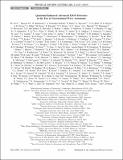Quantum-Enhanced Advanced LIGO Detectors in the Era of Gravitational-Wave Astronomy
Author(s)
Tse, Maggie; Yu, Haocun; Fernandez Galiana, Alvaro-Miguel; Barsotti, Lisa; Evans, Matthew; Fritschel, Peter K; Mansell, Georgia; Matichard, Fabrice; Mavalvala, Nergis; McCuller, Lee P; Miller, J.; Oelker, Eric Glenn; Phinney, Isabelle Y.; Whittle, Christopher Mark; Biscans, Sebastien; Buikema, Aaron; Gras, Slawomir; Lane, B. B.; MacInnis, Myron E; Mason, Kenneth R; Massinger, Thomas J.; Mittleman, Richard K; Weiss, Rainer; Yu, Hang; Zucker, Michael E; ... Show more Show less
DownloadPublished version (834.5Kb)
Publisher with Creative Commons License
Publisher with Creative Commons License
Creative Commons Attribution
Terms of use
Metadata
Show full item recordAbstract
© 2019 authors. Published by the American Physical Society. Published by the American Physical Society under the terms of the https://creativecommons.org/licenses/by/4.0/ Creative Commons Attribution 4.0 International license. Further distribution of this work must maintain attribution to the author(s) and the published article's title, journal citation, and DOI. The Laser Interferometer Gravitational Wave Observatory (LIGO) has been directly detecting gravitational waves from compact binary mergers since 2015. We report on the first use of squeezed vacuum states in the direct measurement of gravitational waves with the Advanced LIGO H1 and L1 detectors. This achievement is the culmination of decades of research to implement squeezed states in gravitational-wave detectors. During the ongoing O3 observation run, squeezed states are improving the sensitivity of the LIGO interferometers to signals above 50 Hz by up to 3 dB, thereby increasing the expected detection rate by 40% (H1) and 50% (L1).
Date issued
2019-12Department
Massachusetts Institute of Technology. Department of Physics; MIT Kavli Institute for Astrophysics and Space ResearchJournal
Physical Review Letters
Publisher
American Physical Society (APS)